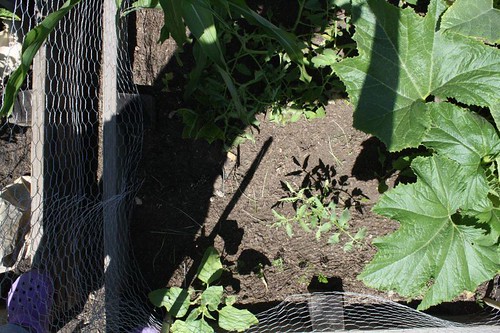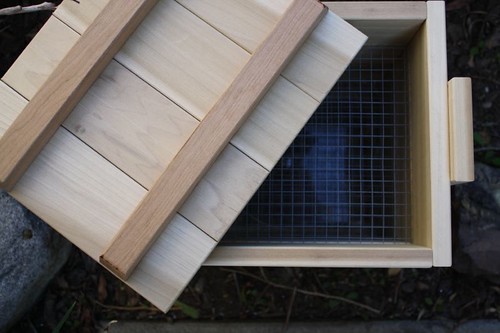I do love composting. (We have even considered a composting toilet for our cottage.) I love the idea that our waste is being turned into something more. I love the way our chickens go nuts when they are allowed near the pile. I even love the way it smells, clean and dirty at the same time (farm girl in me perhaps), and the way it feels as I shovel and mix it into our raised garden beds. I love how it has become commonplace - and how routine it has become for our kids to dump scrap into the small container under our kitchen sink, then trudge it out to the bin at the end of the day. (Though any advice on how to get a composting program into our public school would be most appreciated! This is one place where it isn't. And should be.) I love that we return our scraps to the earth to feed the food we are growing.


We have always kept a traditional compost bin in our yard for all of our green and brown waste. It was a bin that the City gave for free, in exchange for attending a Composting class, provided by the City's Department of Public Works. (Class schedule can be found here. It looks like you now pay for a bin, but at a very fair price.) Sitting in the farthest corner - near our pool we regularly dumped garden debris and kitchen waste into it. It is extremely dry where we live, and with our dry garden (not a lot of green - and lots of brown waste)we had to make sure it stayed moist. We added water - and D even added, um, urine. (Urine has long been considered a great compost activator.) It works pretty well. In landscaping our yard, we moved the bin closer to the house, and are in the process of reestablishing our pile. I think two bins may be the answer to better productivity. We will see.
The premise of composting is simple: the rotting green matter (lawn trimmings, kitchen scraps, chicken poop, etc.) you might have just thrown in the trash is piled up, together with dry material (dry leaves, newspaper - preferably not the glossy pages, and only if soy based inks have been used, unfinished cardboard, twigs, straw etc). The rotting material(about 1/3 of the mix) produces nitrogen and the dry (2/3), provides carbon. Magically it turns into food and soil for your plants. (Well, not really magically - "the course of decomposition of organic matter is affected by the presence of carbon and nitrogen. The C:N ratio represents the relative proportion of the two elements...Actually, the ratio of available carbon to available nitrogen is the important relationship because there may be some carbon present so resistant to biological attack that its presence is not significant." --from Compost Fundamentals) There are many things you can compost. And many you shouldn't. And of course some overlap of the two. (In the class I took, the final destination of the compost was considered. For example, laundry lint composted may be ok for your flower bed, but the treatments and detergents that may be present in the lint would not be desirable for our organic veggie bed.)
We are taking our home composting to the next level with vermicomposting. D built a worm-bin for my birthday (a gift that keeps on giving!) after I dropped many a hint. I sent him a link to this website, and he built a bin out of the scrap in his woodshop. (Though frankly the website prices are so reasonable if we had had to purchase the wood it might have been cheaper just to order it.) It is a little small. But we are excited by the possibilities. I have a friend who is gathering up some worms for us, and we are ready to get started!


The premise with vermicomposting is the same really - the C:N ratio though is a little less important as the worms do much of the work that would be done by the chemical reaction. In the end, you get a rich material to enhance your soil, as well as the possibility of making vermicompost tea - which some tout as a miracle worker for plant growth and protection against disease.
Resources:
Favourite books on my shelf with sections on Home Composting include:
Ann Lovejoy's Organic Garden Design School
A Slice of Organic Life by Sheherasade Goldsmith
Garden Anywhere by Alys Fowler
Really if you "google" composting / vermicomposting you will be overwhelmed by available material. There is lots out there to guide you.
A few on-line highlights:
Design Sponge did a wonderful recent post on composting
Groovy Green has straight-forward instructions on building a simple worm bin.
The Gaiam site has lots of information on choosing the composter that is right for you, and how to get started.
I love this idea: Host a community Build a Worm Bin Day!
Say no more. Composting 101
If you are interested in taking a class from John Lyons - and I highly recommend any class he is giving - his schedule can be found here.
Oh, and one last thing; with Thanksgiving around the corner, don't forget to re-read FPea's great post here on composting your holiday party!
Happy Holidays!

5 comments:
I have been impressed by the growth of my vegetables after I started adding my own compost. I didn't know it would have such an impact! My carrots were huge this year.
Composting and worm farms are great. I really liked the quality of the worm castings, and they were great on the garden.
Our only problem with our worm farm was the really hot weather. We had a couple of days of 40 degree-plus heat a few summers back, and we just couldn't keep our worms cool enough. Many baked, which left us feeling horrible. While the worm population recovered, we never felt the same way about keeping worms again.
And yesterday, some animal visiting our garden tipped over our very full and heavy compost bin!
Despite these issues, we're still committed composters.
THAT is a fantastic looking worm bin! I actually own one from Wood Worm Farms, and while certainly a nice (and functional) system, one of the issues I have with it is that the trays are too shallow. It doesn't hold enough material and tends to dry out way too quickly (especially when you are absent minded like me - haha). Your system looks like it has nice thick walls and deeper trays. Very cool!
People should be reading your blog so they'd know how to keep the environment clean.
It's curious that the chickens like it so much, do you know why?
What do you put in the worm bin?
Post a Comment